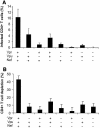Vpr and Vpu are important for efficient human immunodeficiency virus type 1 replication and CD4+ T-cell depletion in human lymphoid tissue ex vivo
- PMID: 15507658
- PMCID: PMC525056
- DOI: 10.1128/JVI.78.22.12689-12693.2004
Vpr and Vpu are important for efficient human immunodeficiency virus type 1 replication and CD4+ T-cell depletion in human lymphoid tissue ex vivo
Abstract
The relevance of the accessory vpr, vpu, and nef genes for human immunodeficiency virus type 1 (HIV-1) replication in human lymphoid tissue (HLT), the major site of viral replication in vivo, is largely unknown. Here, we show that an individual deletion of nef, vpr, or vpu significantly decreases HIV-1 replication and prevents CD4+ T-cell depletion in ex vivo HLT. However, only combined defects in all three accessory genes entirely disrupt the replicative capacity of HIV-1. Our results demonstrate that nef, vpr, and vpu are all essential for efficient viral spread in HLT, suggesting an important role in AIDS pathogenesis.
Figures




Similar articles
-
Contribution of Vpu, Env, and Nef to CD4 down-modulation and resistance of human immunodeficiency virus type 1-infected T cells to superinfection.J Virol. 2006 Aug;80(16):8047-59. doi: 10.1128/JVI.00252-06. J Virol. 2006. PMID: 16873261 Free PMC article.
-
Could Nef and Vpr proteins contribute to disease progression by promoting depletion of bystander cells and prolonged survival of HIV-infected cells?Biochem Biophys Res Commun. 2000 Jan 27;267(3):677-85. doi: 10.1006/bbrc.1999.1708. Biochem Biophys Res Commun. 2000. PMID: 10673351 Review.
-
[Functional roles of HIV-1 accessory genes for its pathogenicity].Tanpakushitsu Kakusan Koso. 2007 Aug;52(10 Suppl):1261-7. Tanpakushitsu Kakusan Koso. 2007. PMID: 17824250 Review. Japanese. No abstract available.
-
CD4 down-modulation by human immunodeficiency virus type 1 Nef correlates with the efficiency of viral replication and with CD4(+) T-cell depletion in human lymphoid tissue ex vivo.J Virol. 2001 Nov;75(21):10113-7. doi: 10.1128/JVI.75.21.10113-10117.2001. J Virol. 2001. PMID: 11581379 Free PMC article.
-
Effect of R77Q, R77A and R80A changes in Vpr on HIV-1 replication and CD4 T cell depletion in human lymphoid tissue ex vivo.AIDS. 2006 Apr 4;20(6):831-6. doi: 10.1097/01.aids.0000218546.31716.7f. AIDS. 2006. PMID: 16549966
Cited by
-
Early Vertebrate Evolution of the Host Restriction Factor Tetherin.J Virol. 2015 Dec;89(23):12154-65. doi: 10.1128/JVI.02149-15. Epub 2015 Sep 23. J Virol. 2015. PMID: 26401043 Free PMC article.
-
Human immunodeficiency virus type 1 inhibits DNA damage-triggered apoptosis by a Nef-independent mechanism.J Virol. 2005 May;79(9):5489-98. doi: 10.1128/JVI.79.9.5489-5498.2005. J Virol. 2005. PMID: 15827163 Free PMC article.
-
Contribution of Vpu, Env, and Nef to CD4 down-modulation and resistance of human immunodeficiency virus type 1-infected T cells to superinfection.J Virol. 2006 Aug;80(16):8047-59. doi: 10.1128/JVI.00252-06. J Virol. 2006. PMID: 16873261 Free PMC article.
-
HIV-1-Mediated Downmodulation of HLA-C Impacts Target Cell Recognition and Antiviral Activity of NK Cells.Cell Host Microbe. 2017 Jul 12;22(1):111-119.e4. doi: 10.1016/j.chom.2017.06.008. Cell Host Microbe. 2017. PMID: 28704647 Free PMC article.
-
HIV-1 Vpr combats the PU.1-driven antiviral response in primary human macrophages.Nat Commun. 2024 Jun 29;15(1):5514. doi: 10.1038/s41467-024-49635-w. Nat Commun. 2024. PMID: 38951492 Free PMC article.
References
-
- Agostini, I., J. M. Navarro, F. Rey, M. Bouhamdan, B. Spire, R. Vigne, and J. Sire. 1996. The human immunodeficiency virus type 1 Vpr transactivator: cooperation with promoter-bound activator domains and binding to TFIIB. J. Mol. Biol. 261:599-606. - PubMed
-
- Aiken, C., J. Konner, N. R. Landau, M. E. Lenburg, and D. Trono. 1994. Nef induces CD4 endocytosis: requirement for a critical dileucine motif in the membrane-proximal CD4 cytoplasmic domain. Cell 76:853-864. - PubMed
-
- Alexander, L., E. Weiskopf, T. C. Greenough, N. C. Gaddis, M. R. Auerbach, M. H. Malim, S. J. O'Brien, B. D. Walker, J. L. Sullivan, and R. C. Desrosiers. 2000. Unusual polymorphisms in human immunodeficiency virus type 1 associated with nonprogressive infection. J. Virol. 74:4361-4376. - PMC - PubMed
Publication types
MeSH terms
Substances
LinkOut - more resources
Full Text Sources
Research Materials

